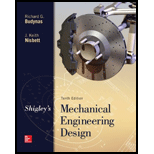
Determine the tensile and yield strengths for the following materials:
- (a) UNS G10200 hot-rolled steel.
- (b) SAE 1050 cold-drawn steel.
- (c) AISI 1141 steel quenched and tempered at 540°C.
- (d) 2024-T4 aluminum alloy.
- (e) Ti-6A1-4V annealed titanium alloy.
(a)
The tensile and yield strength of the UNS G10200 hot-rolled steel.
Explanation of Solution
The ability of material to withstand pulling force is called as tensile strength. The tensile strength express as the force per unit area.
The amount of stress that causes permanent deformation in the material is called as yield strength. It is the maximum stress after which the material changes their shape. The material deforms permanently after the elastic limit.
Refer to the Table A-20 “Deterministic ASTM Minimum Tensile and Yield Strengths for Some Hot-Rolled (HR) and Cold-Drawn (CD) Steels” to obtain the tensile and yield strength as
Thus, the tensile strength and the yield strength for the UNS G10200 hot-rolled steel is
(b)
The tensile and yield strength of SAE 1050 cold-drawn steel.
Explanation of Solution
Refer to the Table A-20 “Deterministic ASTM Minimum Tensile and Yield Strengths for Some Hot-Rolled (HR) and Cold-Drawn (CD) Steels” to obtain the tensile strength and the yield strength of the SAE 1050 cold-drawn steel as
Thus, the tensile strength and the yield strength of SAE 1050 cold-drawn steel is
(c)
The tensile and yield strength of AISI 1141 steel quenched and tempered at
Explanation of Solution
Refer to Table A-21 “Mean Mechanical Properties of some Heat-Treated Steels” to obtain the tensile and yield strength for the AISI 1141 steel quenched and tempered at
Thus, the tensile strength and the yield strength of the AISI 1141 steel quenched and tempered at
(d)
The tensile and yield strength of the 2024-T4 aluminum alloy.
Explanation of Solution
Refer to Table A-22 “Result of Tensile Tests of Some Metals” to obtain the tensile and yield strength of aluminum alloy as
Thus, the tensile strength and the yield strength of the 2024-T4 aluminum alloy. is
(e)
The tensile and yield strength of the Ti-6Al-4V annealed titanium alloy.
Explanation of Solution
Refer to Table A-24(c) “Mechanical Properties of some Titanium Alloys ” to obtain the tensile and yield strength of Ti-6Al-4V annealed titanium alloy as
Thus, the tensile strength and the yield strength of Ti-6Al-4V annealed titanium alloy is
Want to see more full solutions like this?
Chapter 2 Solutions
Shigley's Mechanical Engineering Design (McGraw-Hill Series in Mechanical Engineering)
- HELP?arrow_forwardTrue and False Indicate if each statement is true or false. T/F 1. Rule #1 protects the function of assembly. T/F 2. One of the fundamental dimensioning rules requires all dimensions apply in the free-state condition for rigid parts. T/F 3. The fundamental dimensioning rules that apply on a drawing must be listed in the general notes. T/F 4. Where Rule #1 applies to a drawing, it limits the form of every feature of size on the drawing. T/F 5. Rule #1 limits the variation between features of size on a part. T/F 6. The designer must specify on the drawing which features of size use Rule #1. T/F T/F T/F 7. Rule #1 applies to nonrigid parts (in the unrestrained state). 8. A GO gage is a fixed-limit gage. 9. Rule #1 requires that the form of an individual regular feature of size is controlled by its limits of sizearrow_forwardFEAarrow_forward
- Please also draw the FBDsarrow_forwardDesign Description: Fresh water tank, immersed in an oil tank.a) Water tank:a. Shape: Cylindricalb. Radius: 1 meterc. Height: 3 metersd. Bottom airlock: 0.2m x 0.2m. b) Oil tank:a. Shape: cylindricalb. Radius: 4 metersc. Oil density: 850 kg/m³ Determine:a) The pressure experienced by an airlock at the bottom of the tank with water.b) The force and direction necessary to open the lock, suppose the lock weighs 20 Newtons, suppose the lock opens outwards. The image is for illustrative purposes, the immersed cylinder does not reach the bottomarrow_forwardNeed help!arrow_forward
 Elements Of ElectromagneticsMechanical EngineeringISBN:9780190698614Author:Sadiku, Matthew N. O.Publisher:Oxford University Press
Elements Of ElectromagneticsMechanical EngineeringISBN:9780190698614Author:Sadiku, Matthew N. O.Publisher:Oxford University Press Mechanics of Materials (10th Edition)Mechanical EngineeringISBN:9780134319650Author:Russell C. HibbelerPublisher:PEARSON
Mechanics of Materials (10th Edition)Mechanical EngineeringISBN:9780134319650Author:Russell C. HibbelerPublisher:PEARSON Thermodynamics: An Engineering ApproachMechanical EngineeringISBN:9781259822674Author:Yunus A. Cengel Dr., Michael A. BolesPublisher:McGraw-Hill Education
Thermodynamics: An Engineering ApproachMechanical EngineeringISBN:9781259822674Author:Yunus A. Cengel Dr., Michael A. BolesPublisher:McGraw-Hill Education Control Systems EngineeringMechanical EngineeringISBN:9781118170519Author:Norman S. NisePublisher:WILEY
Control Systems EngineeringMechanical EngineeringISBN:9781118170519Author:Norman S. NisePublisher:WILEY Mechanics of Materials (MindTap Course List)Mechanical EngineeringISBN:9781337093347Author:Barry J. Goodno, James M. GerePublisher:Cengage Learning
Mechanics of Materials (MindTap Course List)Mechanical EngineeringISBN:9781337093347Author:Barry J. Goodno, James M. GerePublisher:Cengage Learning Engineering Mechanics: StaticsMechanical EngineeringISBN:9781118807330Author:James L. Meriam, L. G. Kraige, J. N. BoltonPublisher:WILEY
Engineering Mechanics: StaticsMechanical EngineeringISBN:9781118807330Author:James L. Meriam, L. G. Kraige, J. N. BoltonPublisher:WILEY





